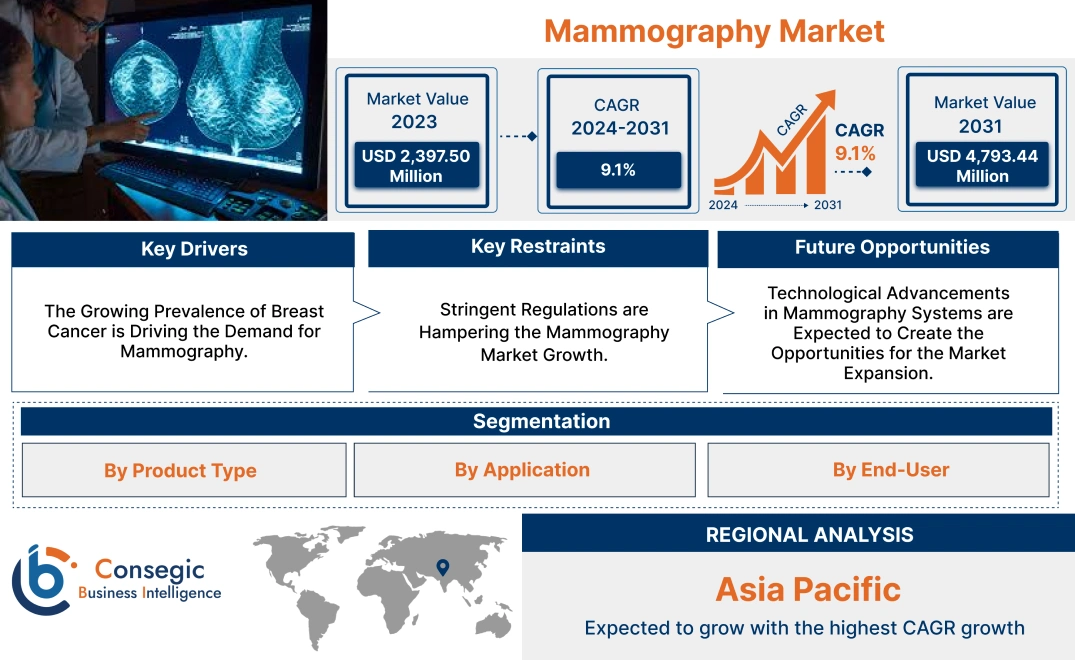Mammography Market Size:
Mammography Market size is growing with a CAGR of 9.1% during the forecast period (2024-2031), and the market is projected to be valued at USD 4,793.44 Million by 2031 from USD 2,397.50 Million in 2023.
Mammography Market Scope & Overview:
Mammography is a medical imaging technique that uses a low-dose x-ray system to examine the breast for the early detection of cancer. It is used as both a screening and diagnostic tool. It creates detailed images of the breast tissue, aiding in the identification of abnormalities such as lumps, microcalcifications, or other changes that indicate the presence of cancerous or benign conditions. It encompasses two categories of these systems including analog and digital systems. An analog system is a traditional method that involves capturing images on film. It has largely been replaced by digital mammography due to its limitations in terms of image quality, storage, and analysis. Digital systems employ detectors to convert X-rays into digital images that are stored, analyzed, and transmitted electronically. Digital system offers several advantages including the ability to manipulate and enhance images for better visualization, easier storage and retrieval, and the potential for computer-aided detection systems to assist radiologists in identifying potential abnormalities.
Mammography MarketDynamics - (DRO) :
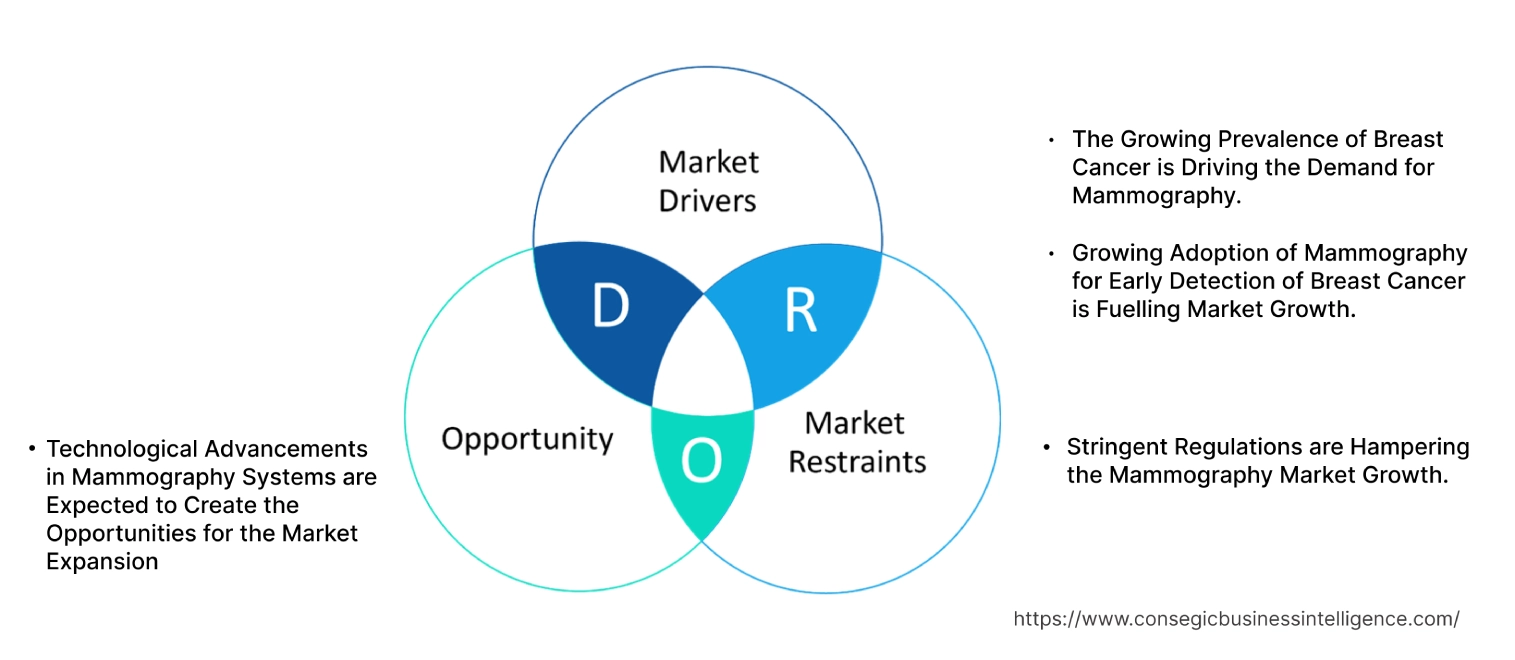
Key Drivers:
The Growing Prevalence of Breast Cancer is Driving the Demand for Mammography.
The rising cases of breast cancer are one of the prominent reasons fuelling the requirement for mammography which is driving the market growth worldwide. Breast cancer is a disease in which abnormal breast cells grow uncontrollably and form tumors. The growing incidences of breast cancer are attributed to multiple risk factors including increasing age, obesity, family history of breast cancer, history of radiation exposure, reproductive history, genetic predisposition, and postmenopausal hormone therapy among others. The increasing prevalence of breast cancer is propelling the requirement for these techniques.
- For instance, according to the data published by the World Health Organization in July 2023, there were 2.3 million women diagnosed with breast cancer and 685,000 deaths globally in 2020. Such a high burden of breast cancer creates the demand for highly accurate diagnostic techniques including mammography.
The high predisposition risk factors have led to a larger number of at-risk individuals requiring regular screening. Additionally, the fright of spreading tumors throughout the body and becoming fatal is a predominant factor creating the requirement for highly accurate diagnostic solutions. Thus, the increasing prevalence of breast cancer with the availability of mammography technologies, is driving the market globally.
Growing Adoption of Mammography for Early Detection of Breast Cancer is Fuelling Market Growth.
Rising awareness about the importance of regular screening and early detection of breast cancer is a major factor creating the adoption of mammography. Early detection of cancer significantly improves treatment outcomes and survival rates of patients. Increasing awareness campaigns and initiatives by healthcare organizations, governments, and non-profit groups to educate women regarding the importance of regular mammograms is significantly boosting the demand.
- For instance, in 2021, the World Health Organization announced the Global Breast Cancer Initiative (GBCI) to assess, strengthen, and scale up services for the early detection and management of breast cancer. The goals of this initiative are health promotion for early detection, timely breast diagnostics, and comprehensive breast cancer management. This initiative aligns with the growing recognition of the importance of breast cancer screening and early intervention.
This influences healthcare providers to invest in cutting-edge diagnostic solutions. As a result, the collective efforts by the leading authorities for the awareness of screening and early detection of breast cancer are significantly boosting the requirement for these systems, thereby driving market growth across the globe.
Key Restraints :
Stringent Regulations are Hampering the Mammography Market Growth.
The market is experiencing significant constraints due to increasingly stringent regulations that hamper the industry’s growth and profitability. The stringent regulatory environment governing the development, approval, and commercialization of medical devices, including mammography significantly impacts market growth. A few of the regulatory bodies are the FDA (Food and Drug Administration) in the US and the EMA (European Medicines Agency) in Europe which impose stringent requirements on manufacturers to ensure the safety and efficacy of medical devices.
These stringent regulations lead to increased development costs, longer approval timelines, and complex compliance processes. Manufacturers must invest substantial resources in clinical trials, regulatory documentation, and quality assurance systems to obtain regulatory approval. This delays product launches and limits market entry for new and innovative technologies. Additionally, regulatory changes and updates create uncertainty and add to the complexity of the regulatory landscape. Thus, as per the analysis, the impact of these stringent regulations on the mammography market expansion is multifaceted.
Future Opportunities :
Technological Advancements in Mammography Systems are Expected to Create the Opportunities for the Market Expansion.
The need for early detection and accurate diagnosis of breast cancer is leading to the development of technologically advanced systems. Advancements such as computer-aided diagnosis, 3D mammography, and the use of artificial intelligence are improving accuracy. Computer-aided detection (CAD) is a computer program that helps radiologists interpret mammograms by highlighting abnormal areas. CAD uses pattern recognition to mark suspicious areas, such as masses, calcifications, and asymmetries, for the radiologist to review.
Additionally, artificial intelligence (AI) is rapidly being incorporated, with AI-powered algorithms analyzing mammograms for automated detection of suspicious areas and risk assessment tools helping to personalize screening strategies for individual patients. Contrast-enhanced mammography (CEM) is another emerging technology that utilizes a contrast agent to enhance the visualization of tumors and improve diagnostic accuracy. The increasing efforts taken by the leading manufacturers to provide advanced systems are expected to propel the market growth.
- For instance, in October 2024, Siemens Healthineers received 510(k) clearance for its Mammomat B. brilliant mammography system. The Food and Drug Administration clearance covered elements involving 2D breast imaging, breast biopsy, and titanium contrast-enhanced mammography. Separately, Siemens filed for premarket approval of the 3D portion of the system.
Overall, the integration of advanced technologies in these systems is expected to create the need for innovation in the market, ultimately leading to improved patient care and earlier cancer detection.
Mammography MarketSegmental Analysis :
By Product Type:
Based on product type, the market is bifurcated into analog and digital systems.
Trends in the Product Type:
- Growing adoption of portable mammography systems.
- Continuous advancements in digital mammography technology, such as AI-powered (Artificial intelligence) image analysis, are improving diagnostic accuracy.
- Increasing popularity of 3D mammography, or tomosynthesis due to its ability to detect cancers earlier and more accurately.
The digital mammography system segment accounted for the largest market share in 2023 and is also expected to grow at the fastest CAGR over the forecast period.
- The segment is further categorized into full-field digital mammography, digital breast tomosynthesis, and others.
- A digital mammography system utilizes a digital detector to capture X-ray beams, converting them into electrical signals that are subsequently processed by a computer.
- This advanced technology replaces the traditional film-based mammography generating high-resolution computerized images of the breast.
- Full-field digital mammography (FFDM) produces a 2D image of the breast. It utilizes a flat-panel detector to capture X-ray images.
- Digital breast tomosynthesis (DBT), also known as 3D mammography, captures multiple X-ray images of the breast from different angles. These images are then reconstructed into a series of thin slices. This system provides better tissue contrast by separating overlapping layers, potentially leading to fewer false positives and biopsies.
- Ongoing technological advancements are resulting in the development of novel digital systems, further boosting the segment in the overall mammography market demand.
- For instance, in November 2024, iCAD, Inc., a provider of clinically proven AI-powered cancer detection solutions, announced that its ProFound Detection Version 4.0 for Digital Breast Tomosynthesis (DBT) received 510(k) clearance from the U.S. Food and Drug Administration (FDA). This next-generation AI solution, trained using advanced deep learning convolutional neural networks (CNN), offers advancements in cancer detection and specificity.
- Overall, the integration of advanced technologies in digital systems is driving a significant trajectory of the segment in the overall mammography market expansion.
By Application :
Based on the application, the market is bifurcated into screening and diagnostic mammography.
Trends in the Application:
- The integration of mammography with other imaging modalities such as MRI (Magnetic Resonance Imaging) and PET scans (positron emission tomography) to improve diagnostic accuracy.
- The use of biomarkers to identify high-risk patients and guide targeted imaging serves as a promising approach.
The screening mammography segment accounted for the largest market share in the year 2023.
- Screening mammography involves using X-rays to detect breast cancer in women who have no symptoms.It is a test that uses a low -dose of X-rays to take four standard images of the breast.
- It serves as a preventive measure aimed at early detection. This significantly improves the chances of successful treatment.
- Regular screening is recommended for women over a certain age, often starting around 40 or 50, depending on individual risk factors.
- For instance, according to the guidelines published in 2022, the National Comprehensive Cancer Network (NCCN) recommends screening mammography every year for women, beginning at age 40.
- Thus, early detection through screening mammography results in earlier diagnosis and treatment, improving patient outcomes.
The diagnostic mammography segment is expected to grow at the fastest CAGR over the forecast period.
- Diagnostic mammography is employed to assess patients exhibiting abnormal clinical signs, such as breast lumps or nipple discharge, identified either by the patient or their healthcare provider.
- Additionally, it is utilized to further investigate anomalies detected during screening mammograms. This diagnosis provides more detailed images of the breast tissue compared to screening mammograms, aiding in the accurate diagnosis and subsequent treatment planning for breast conditions.
- If a suspicious area is identified, further diagnostic tests, such as a breast ultrasound or biopsy, are recommended.
- The growing prevalence and increasing incidences of breast cancer are creating the requirement for diagnostic mammography.
- Thus, as per the analysis, diagnostic mammography plays a crucial role in accurately diagnosing breast cancer and guiding appropriate treatment plans.
By End-User:
Based on end users, the market is categorized into hospitals, ambulatory surgery centers, diagnostic centers, and others.
Trends in the End User:
- The provision of mobile mammography units is expanding access to screening services, especially in underserved areas.
- Integration of mammography systems with EHRs (Electronic Health Records) to streamline patient data management and improve clinical workflows.
- Incorporating telehealth technologies to provide remote consultations and image interpretation, expanding access to specialized care.
The hospitals segment accounted for the largest mammography market share of 50.02% in the year 2023.
- Hospitals serve a crucial role as primary centers for comprehensive treatment for breast cancer, offering a sophisticated ecosystem of medical expertise and advanced technologies.
- Hospitals account for higher requirements for mammography systems as they possess a large volume of screenings with diverse patient populations.
- Additionally, they are equipped with advanced imaging technologies and experienced radiologists to provide comprehensive breast cancer screening and diagnostic services.
- Hospitals often have dedicated breast health centers that offer a range of services, including screening and diagnostic mammograms, and interventional procedures like biopsies. They cater to a diverse patient population, including those with complex medical conditions and those requiring specialized care.
- Moreover, the increasing initiatives by hospitals to improve breast cancer diagnosis are raising the requirement for these systems.
- For instance, in May 2023, TGH Imaging (Tampa General Hospital) increased patient access across four counties for breast cancer screening by adding Genius 3D Mammography developed Hologic to 18 locations in Hillsborough, Pasco, Pinellas, and Palm Beach counties. 3D mammography creates a 3D image of the breast that allows better detection of breast cancer.
- Furthermore, hospitals are adopting mobile units to increase awareness about the early detection of breast cancer further accelerating the segment trajectory.
The diagnostic centers segment is expected to grow at the fastest CAGR over the forecast period.
- Diagnostic centers specialize in providing diagnostic imaging services, including mammography. These centers are equipped with state-of-the-art equipment and employ experienced radiologists to interpret images and provide accurate diagnoses.
- Diagnostic centers often collaborate with hospitals and healthcare providers to offer comprehensive breast health services. They cater to a wide range of patients, including those referred by primary care physicians and those seeking second opinions.
- Additionally, these centers invest in the latest mammography equipment, prioritize efficient processing of mammograms, and focus on patient convenience to improve early detection of breast cancer.
- For instance, in December 2023, RadNet, Inc., the leader in providing high-quality, cost-effective outpatient diagnostic imaging services, announced MammogramNow, an innovative screening mammography program. This pioneering initiative aims to enhance breast health awareness and accessibility, including the integration of cutting-edge DeepHealth technology providing women with convenient access to crucial breast cancer screening services.
- Overall, diagnostic centers, with their specialized expertise, advanced technology, and patient-centric approach, play a pivotal role in the early detection and diagnosis of breast cancer, contributing significantly to segment trends in the upcoming years.
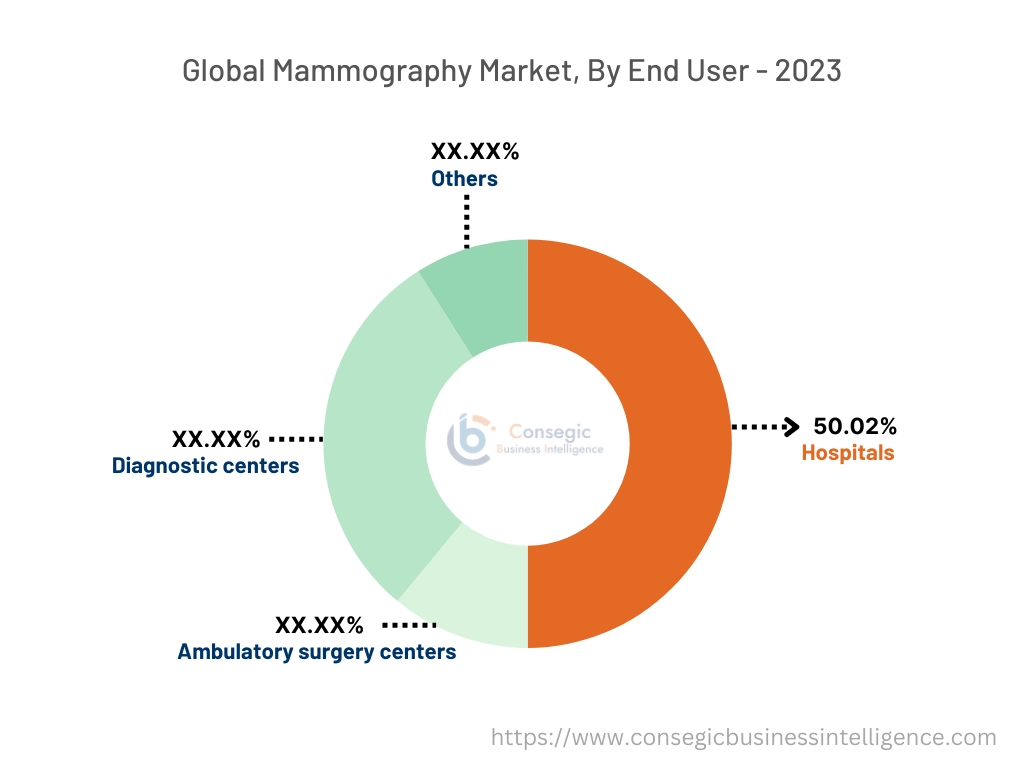
Regional Analysis:
The regional segment includes North America, Europe, Asia Pacific, the Middle East and Africa, and Latin America.
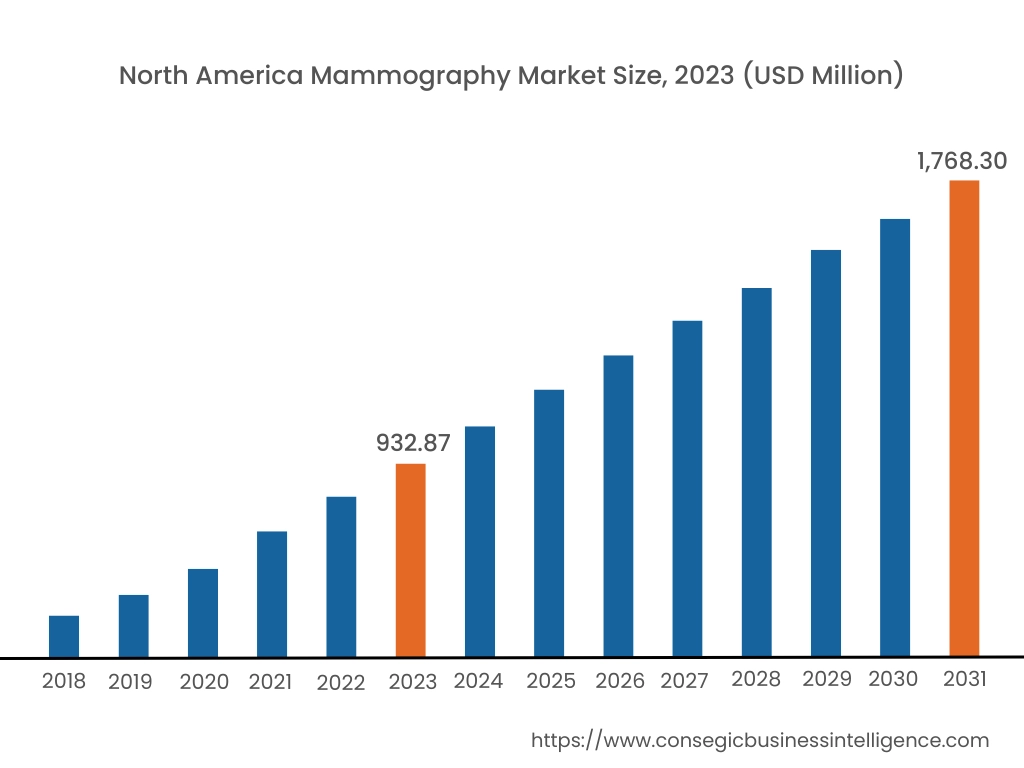
In 2023, North America accounted for the highest market share at 38.91% and was valued at USD 932.87 Million and is expected to reach USD 1,768.30 Million in 2031. In North America, the U.S. accounted for the highest share of 69.31% during the base year of 2023.
The North American region holds the dominant position in the mammography market share owing to factors such as the increasing prevalence of breast cancer, the presence of well-developed healthcare systems, and the accessibility of technologically advanced systems. Additionally, the rising awareness of breast cancer and proactive screening practices are driving the need for advanced systems.
The region boasts widespread adoption of regular mammograms due to extensive public health campaigns and insurance coverage for preventive care. The region has a strong focus on early detection and preventive healthcare, leading to a high requirement for mammography for early diagnosis of breast cancer.
- For instance, in October 2024, the Ontario government announced that women over the age of 40 can self-refer for publicly funded mammograms through the Ontario Breast Screening Program (OBSP). To support this rise of publicly funded mammograms, the province has invested nearly USD 20 million to increase the ability of participating OBSP partners to connect more women to screening by adding more site hours, appointment spots, and training additional staff.
Additionally, the presence of key market players and regulatory support contribute to the market's trajectory. Thus, the combination of advanced healthcare infrastructure, strong government initiatives, and increasing awareness about breast cancer has solidified North America's leading position in the global mammography market trend.
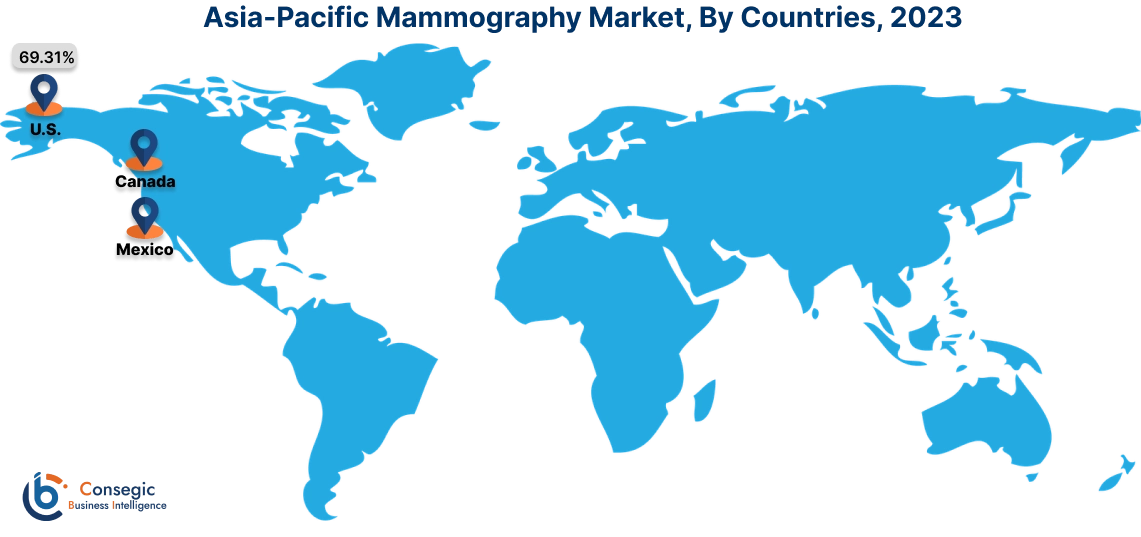
Asia Pacific is experiencing the fastest growth with a CAGR of 11.0% over the forecast period. As per the mammography market analysis, this region is experiencing a rise fueled by increasing healthcare expenditure, rising awareness about breast cancer, and a growing geriatric population. Countries including China, India, and Japan are witnessing significant investments in healthcare infrastructure and the adoption of advanced medical technologies. Additionally, government initiatives to promote early detection and preventive healthcare are contributing to the market's trajectory. Governments in several countries are launching awareness campaigns to educate women about the importance of early breast cancer detection. Thus, as the healthcare landscape in the Asia Pacific region continues to evolve, the requirement for services is expected to grow steadily, offering mammography market opportunities.
Europe is a significant player in the global mammography market demand characterized by a well-established healthcare infrastructure with a focus on early detection and preventive care and a strong regulatory framework. Countries including Germany, France, and the UK have well-established healthcare systems, healthcare industry, and strong government initiatives for breast cancer screening. The region has a high prevalence of breast cancer, leading to a significant requirement for diagnostic and screening systems. Many European countries have implemented national screening programs to encourage regular breast cancer screening. These programs often include mammography as a key component, further boosting market demand. Moreover, the increasing adoption of advanced technologies is further driving the mammography market.
Based on mammography market analysis, the Middle East and Africa region presents a complex and diverse landscape. Increasing healthcare expenditure and government initiatives are driving market trajectory. Additionally, the burgeoning healthcare sector in the Middle East is playing a pivotal role in the mammography market trend. Countries in this region are investing heavily in modern healthcare infrastructure and advanced medical technologies. This increased investment is facilitating the development of hospitals, diagnostic centers, and ambulatory centers. The combined impact of these factors is creating a favorable environment for the trajectory of the market in the MEA region.
Latin America is an emerging region for the mammography market, driven by factors such as increasing healthcare expenditure, rising awareness about breast cancer, and the growing middle class. Countries including Brazil and Mexico are witnessing significant investments in healthcare infrastructure and the adoption of advanced medical technologies. Investments in healthcare infrastructure, particularly in urban areas, are improving access to diagnostic services. These factors collectively present a promising mammography market opportunity for healthcare providers and medical device manufacturers to develop and deliver innovative systems to address the needs of individuals with breast cancer in Latin America.
Top Key Players & Market Share Insights:
The mammography market is highly competitive with major players providing products to the national and international markets. Key players are adopting several strategies in research and development (R&D) and product innovation to hold a strong position in the global mammography market. Key players in the mammography industry include-
- Siemens Healthcare Private Limited (Germany)
- GE HealthCare (U.S)
- Allengers (India)
- Narang Medical Limited (India)
- Metaltronica S.p.A. (Italy)
- SternMed GmbH. (Germany)
- FUJIFILM (Japan)
- Koninklijke Philips N.V. (Netherlands)
- IMS Giotto S.p.A (Italy)
- Hologic, Inc. (U.S)
Recent Industry Developments :
Product Approval:
- In November 2024, iCAD, Inc., a provider of clinically proven AI-powered cancer detection solutions, announced that its ProFound Detection Version 4.0 for Digital Breast Tomosynthesis (DBT) received 510(k) clearance from the U.S. Food and Drug Administration (FDA). This next-generation AI solution, trained using advanced deep learning convolutional neural networks (CNN), offers advancements in cancer detection and specificity.
- In October 2024, Siemens Healthineers received 510(k) clearance for its Mammomat B. brilliant mammography system. The Food and Drug Administration clearance covered elements involving 2D breast imaging, breast biopsy, and titanium contrast-enhanced mammography.
New Launch:
- In November 2023, GE HealthCare announced the release of a new, all-in-one platform of artificial intelligence (AI) apps to support clinicians with breast cancer detection and improved workflow productivity called MyBreastAI Suite. With this initial release, MyBreastAI Suite integrates three AI applications from iCAD including ProFound AI for DBT, SecondLook for 2D Mammography, and PowerLook Density Assessment to help support early detection and improve patient outcomes, as well as help radiology departments improve operational productivity.
Mammography Market Report Insights :
| Report Attributes | Report Details |
| Study Timeline | 2018-2031 |
| Market Size in 2031 | USD 4,793.44 Million |
| CAGR (2024-2031) | 9.1% |
| By Product Type |
|
| By Application |
|
| By End-User |
|
| By Region |
|
| Key Players |
|
| North America | U.S. Canada Mexico |
| Europe | U.K. Germany France Spain Italy Russia Benelux Rest of Europe |
| APAC | China South Korea Japan India Australia ASEAN Rest of Asia-Pacific |
| Middle East and Africa | GCC Turkey South Africa Rest of MEA |
| LATAM | Brazil Argentina Chile Rest of LATAM |
| Report Coverage |
|
Key Questions Answered in the Report
How big is the Mammography market? +
In 2023, the Mammography market is USD 2,397.50 Million.
Which is the fastest-growing region in the Mammography market? +
Asia Pacific is the fastest-growing region in the Mammography market.
What specific segmentation details are covered in the Mammography market? +
Product Type, Application, and end-user segmentation details are covered in the Mammography market.
Who are the major players in the Mammography market? +
Siemens Healthcare Private Limited (Germany), GE HealthCare (U.S), and SternMed GmbH. (Germany) are some of the major players in the market.
